Apple's 2010 MacBook Air (11 & 13 inch) Thoroughly Reviewed
by Anand Lal Shimpi on October 26, 2010 10:08 PM EST- Posted in
- Mac
- Apple
- MacBook Air
- Laptops
The SSD: Not Half Bad
Apple advertises the new MacBook Air as being instant on as a result of the internal SSD. That’s mostly untrue. From a completely powered off state the MacBook Air still takes time to boot. That time is significantly reduced compared to the old MacBook Air and any other Mac with a conventional hard drive. It’s even a shorter boot than my MacBook Pro with a SandForce SF-1200 based SSD in it:
| System Performance Comparison | ||||||
| Boot | Shut Down | Sleep | Awake | |||
| 11-inch MacBook Air | 15.5 seconds | 2.2 seconds | 1.0 second | 1.63 seconds | ||
| 13-inch MacBook Air | 14.4 seconds | 1.9 seconds | 1.0 second | 1.56 seconds | ||
| 13-inch MacBook Air (Late 2008) | 34.4 seconds | 2.9 seconds | 1.6 seconds | 4.19 seconds | ||
| 15-inch MacBook Pro (SF-1200 SSD) | 19.1 seconds | 1.8 seconds | 1.5 seconds | 2.3 seconds | ||
| 15-inch MacBook Pro (Mid 2009, HDD) | 34.2 seconds | 2.8 seconds | 1.8 seconds | 2.1 seconds | ||
You'll notice that even the SF-1200 SSD in my 15-inch MacBook Pro takes longer to boot than these new Airs. Apple does customize the firmware on its SSDs. I’d be willing to bet the SSD in the MacBook Air has tight integration with OS X to guarantee quicker than normal boot times.
Clearly the new Air isn't instant on from a boot standpoint, but it's pretty much there from a recover-from-sleep standpoint. The new Airs both go to sleep and wake up from sleep quicker than any of the other Macs, including my upgraded 15-inch Core i7 MacBook Pro. Again, nothing can trump Apple's tight integration between hardware and software.
Apple likes to work with two different controller manufacturers for SSDs: Samsung and Toshiba. iFixit already confirmed Toshiba is in the new MacBook Air with its teardown:
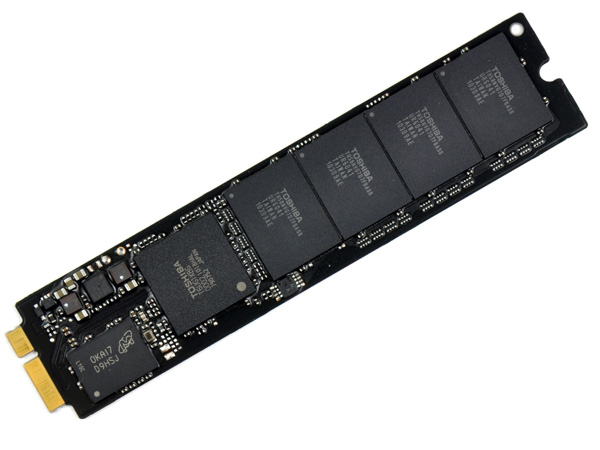
The 11-inch MacBook Air SSD, courtesy of iFixit
The SSD isn’t in an industry standard form factor, although the connector appears to be either micro or mini SATA. Presumably 3rd party SSD manufacturers (ahem, SandForce partners I’m looking at you) could produce drop in replacements for the MacBook Air SSD.
There’s nothing particularly innovative about the form factor of the SSD, other than Apple did away with the unnecessary space a 2.5” SSD would require. Just as SSDs will break the traditional SATA interface barriers, we’ll see the same happen to form factors as well.
The part number on the Toshiba controller may look familiar to some of you. It’s the same controller that’s in Kingston’s SSDNow V+ Series and the SSDNow V Series Boot Drive. I reviewed the latter not too long ago and found that it was a good drive for the money, and here’s the kicker: the SSDNow V Series Boot Drive was amazingly resilient when written to without TRIM support. Its performance hardly dropped as a result of normal desktop use. This is very important because although OS X 10.6.4 has a field for reporting TRIM support on an SSD, the instruction isn’t actually supported by the OS. Even the new MacBook Airs don’t ship with a version of OS X with TRIM support.
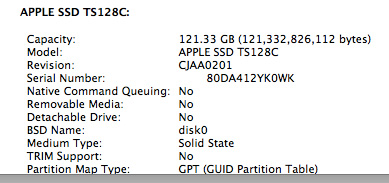
The SSD only has four NAND devices on it. Typically that would mean some very low transfer speeds, particularly on writes. But each one of those four devices has at least 16GB of NAND, spread across multiple planes and die. With the right firmware, you should be able to extract a good deal of parallelism from this architecture. Apple and Toshiba apparently do just that.

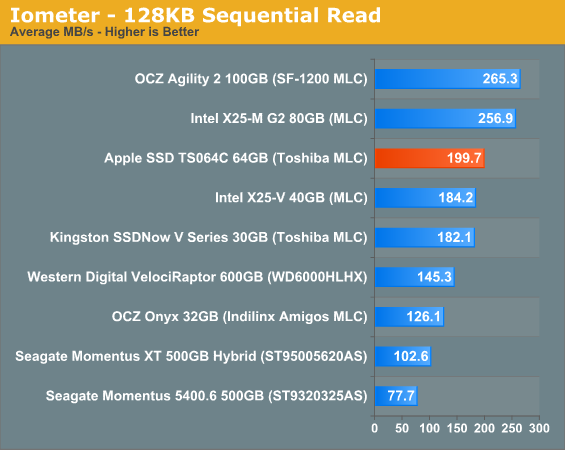
While most value SSDs top out at under 100MB/s, we get nearly 200MB/s sequential reads and writes out of the SSD in the new MacBook Air. And fortunately, Apple hasn’t only focused on sequential performance. The random read/write performance of the new MacBook Air SSD isn’t terrible:
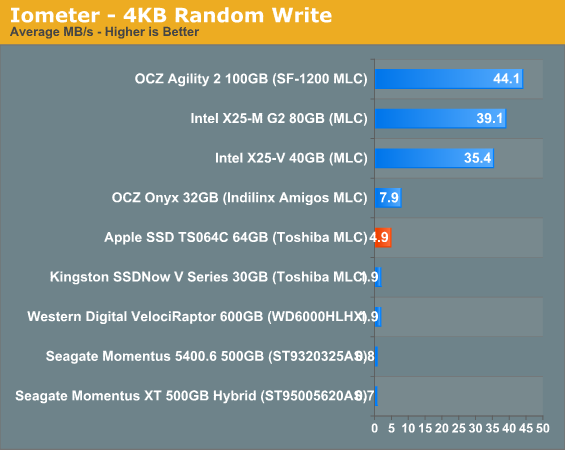
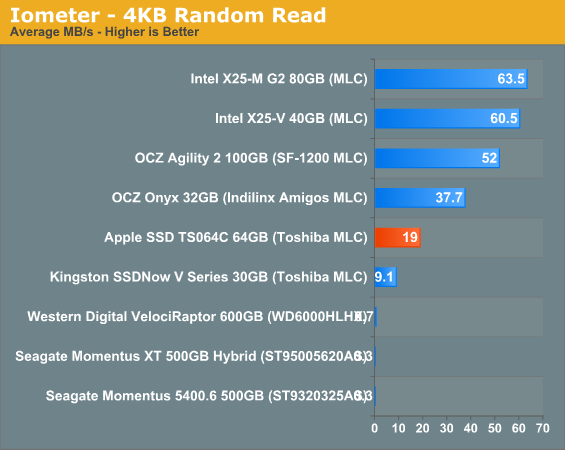
Random write performance is of course the weak point, but you’ll notice that it’s actually higher than the Kingston drive that uses the same controller. While Apple would’ve been better off striking a deal with Intel or SandForce for the controller in the MacBook Air, the Toshiba controller isn’t horrible.
As I mentioned earlier, resilience is very important as OS X still doesn’t support TRIM. I filled the drive with garbage and then tortured it for 20 minutes with random writes. The resulting performance drop was noticeable, but not unbearable:
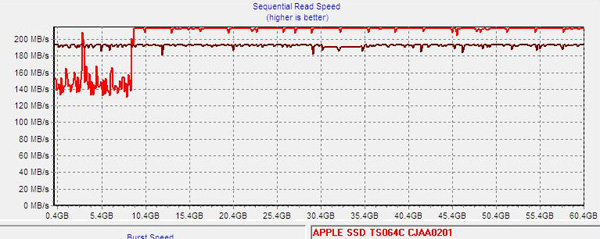
A single pass of sequential writes restores performance to normal:
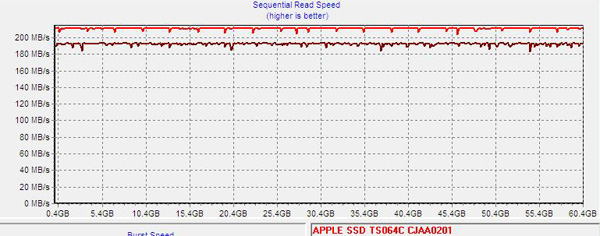
This tells us two things. First, through normal use the drive should be able to recover its performance over time (assuming you give it enough spare area). And second, if there’s any idle garbage collection in Apple’s custom firmware for the Toshiba controller it should be able to keep the drive running at peak performance even without TRIM supported in the OS. I don’t have a good way of measuring whether or not there’s GC enabled on the drive in OS X, but I suspect Apple is (at least it appears to be doing so on the Mac Pro’s SSDs).
Overall I’m pleased with Apple’s SSD selection. It could’ve been a lot better but it could’ve been a lot worse. The MacBook Airs in their default configuration have better IO performance than any other standard config Mac sold on the market today, including the Mac Pro.










185 Comments
View All Comments
khimera2000 - Wednesday, October 27, 2010 - link
but on the flip side many of those larger notebooks make up for graphic loss with a stronger processer, which these will not be able to compete with, not to mention that although it is using a NV320, it is not the discreet model it is the intergrated model which saps your ram just like a netbook not to mention that you can play movies on a netbook. the point of a hard drive is rather mute since you yourself acknowledge that solid state drives exist on netbooks.to assume that netbooks will stay as slow as there oridional releas is kinda off, since technolagy moves at a fast rate. comparing this system to new systems that are released by other companies there is no where that it fits other than as a netbook since your going for the bottom of the barrel for Nvidia cards, and going for a CPU that can be smacked by a I3 mobile theres nothing coming out slower for PC then this unless you look at netbooks.
with this in mind it still just looks like a netbook performance revision.
appliance5000 - Friday, October 29, 2010 - link
So somewhere in this verbiage you're saying it a really really fast and powerful netbook. Ok - if it makes you happy -OK.Demoure - Wednesday, October 27, 2010 - link
Why must it be under 3 pounds? I can't think of a good reason for requiring a laptop under 3 pounds, other than that you are intentionally being picky so as to show it in a better light. At four and a half pounds you have the m11x, a far superior laptop. It is not thin or light, but it is not thick and heavy. Being a scrawny person myself, I cannot think of a person where the 1.5 extra pounds would be a deal breaker.And I do agree with you, it is not a netbook, unlike what the other replier said. It is powerful enough to do what netbooks cannot. As I describe netbooks, they fall short if you try to do anything other than text-based stuff. Ion blurs the lines a little, I've owned an ion laptop before. It was able to play movies flawlessly, but beyond that it was still limited in a netbook way. However, my m11x, and as the performance of the air is not too far off, are quite competent at a variety of things. Just about the only thing I would use my desktop for, but not my m11x, would be the heavy work of encoding, transcoding, that sort of stuff. For everything else, it really does feel like a full fledged laptop, if not a decent desktop. The processor being the limiting factor of the laptop, it is fast enough for everything reasonable.
tno - Wednesday, December 29, 2010 - link
This might sound slight to you but is reasonably significant to me. I'm a paramedic with a transport service based out of a tertiary care center (large hospital). This is very much a transient job, you are either in an ambulance going from one place to the next or in a helicopter doing the same. I like to keep some essentials with me at all times: food, water, phone charger, phone, reading material, lightweight computing option. Now phone goes in a pocket. Water has its own bottle. The rest has to go in my bag.After making do with a bulky laptop bag I decided I needed something slimmer and more useful. So I now have a 20L day pack from North Face. It has a laptop compartment/hydration bladder sleeve, and two water resistant compartments, as well as a few smaller pockets and a rain cover for real wet work. And it ways about 1/4 pound. It's amazing, especially compared to my old two pound bag that was bulky while not actually carrying much more stuff.
Food (two Power bars, a PBJ, an apple and some dried fruit/nuts) is about 1 1/2 lbs. Reading material is about 1/2 lbs. Phone charger's a few ounces. So that's about 2 1/2 lbs, including the bag. A 4 1/2 lbs laptop would bring me up to seven pounds. My Lenovo S10 with a 9 cell battery weighs about 3 lbs and having put both used that and my old Dell 15" lappy (about 4.5 lbs) I was much happier with the S10. One handed transitions from one place to another without having to close the laptop is one maneuver that definitely favors the S10 and one I do a lot.
As much as I'm bumping up all these Mac posts I'm going to start to sound like quite the fan boy. That said I still don't own one. And am having trouble making up my mind on which one to buy. The 13MBA and 13MBP vary by just enough to make the MBP's performance equally as tempting as the MBA's lightness. What a travesty of options.
omega12 - Wednesday, October 27, 2010 - link
Did you just compare the power consumption of an unplugged laptop vs a plugged in laptop? The photo on the left says 0W DC Input and on the right we have 22.97W DC Input. What's up with that?Anand Lal Shimpi - Wednesday, October 27, 2010 - link
Cropped the wrong screenshot, the actual processor power consumption doesn't change when plugged in vs. not in OS X but I ran the test both ways just to be sure.Fixed :)
Take care,
Anand
QChronoD - Wednesday, October 27, 2010 - link
Did you guys test the battery life for the air while running windows? Did I miss it on the charts?I need to replace my old laptop w/ something small so I can carry it all day at school. I don't need lots of power, but most of the software I need to use in lab don't run on OSX (AFAIK).
Anyone know anything else for about $1K that is as thin and light and runs for 4+ hours??
JMS3072 - Wednesday, October 27, 2010 - link
Try the ThinkPad X201.kavanoz - Wednesday, October 27, 2010 - link
You can also check Acer Aspire TimelineX AS1830T-3721. Just make sure to swap out the HDD with a SDD. I put a 40 GB Intel X25-V when I bought it and it just flies. Nowadays a 64 GB Sandforce based SSD makes more sense. You can find them for as low as $120.Demoure - Wednesday, October 27, 2010 - link
Compare it to a netbook and you will be delighted at how speedy and thin it is. Compare it to the ipad and well.. okay so the ipad is a bit silly no matter the comparison. Compare it to asus's UL series, and there you have a decent comparison. Thats one where it could really go either way, based on personal preference and which camp you side with. But when the new air launched, I wondered why a reasonable person would want it over an m11x. It is thinner, certainly.. but, is that really important? No laptop these days is really the thickness of a brick, to judge size, you would think people would be more concerned about length and width. Screen size. How thin the air is.. seems like it would never factor in to any situation. Places where an air can fit, a culv-type laptop would as well. If not for it being thin, I really can't think of a reason to get it over the m11x. Neither are really BAD buys, but the air just seems less impressive in comparison. With the money saved by getting the old r1 (you know, the one with more battery life, cheaper, just as useful, only lacking in its lack of optimus) you could get yourself a fancy ssd, to complete the package. Perhaps I am just baised after finding the m11x to be the perfect little laptop, but despite it being a hideous looking thing, I see no reason to get the air unless you just have to have an apple computer. However if the m11x did not exist, I would not blame anyone for getting an air. It is well rounded.